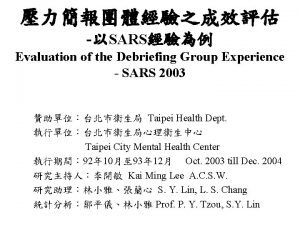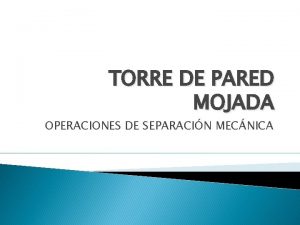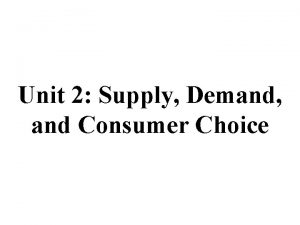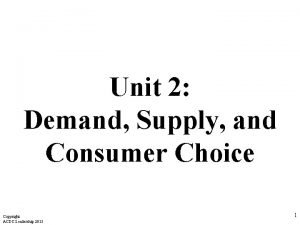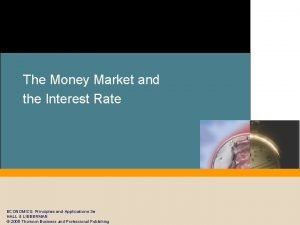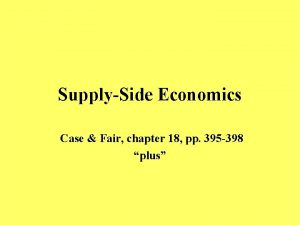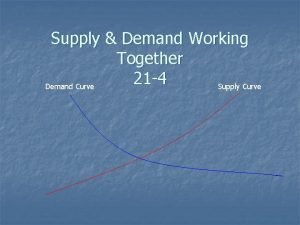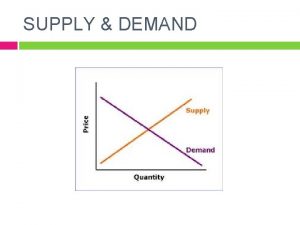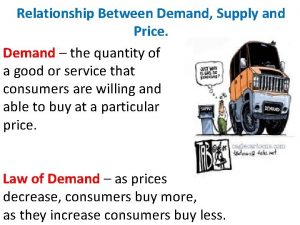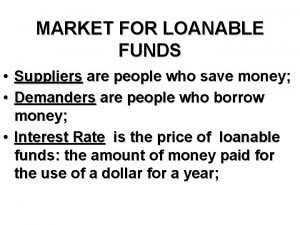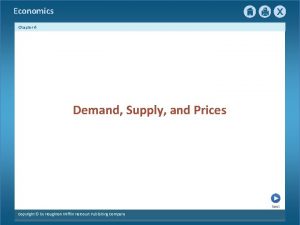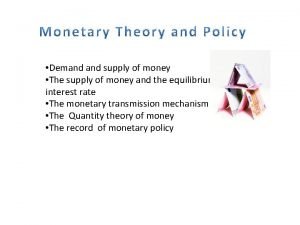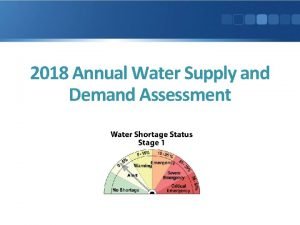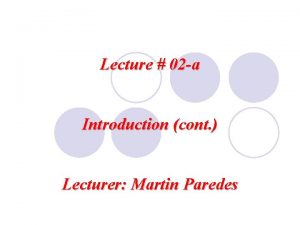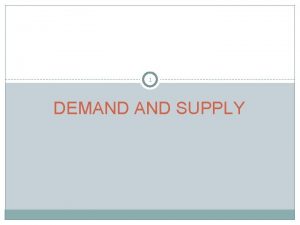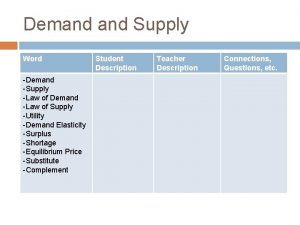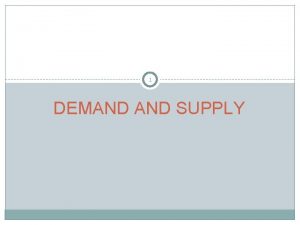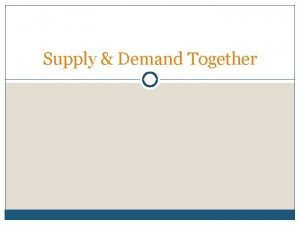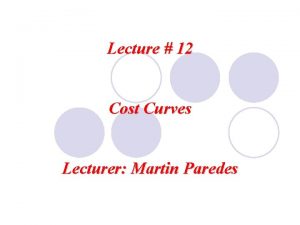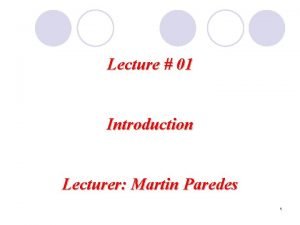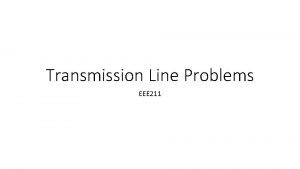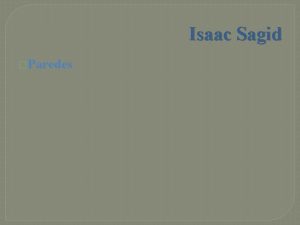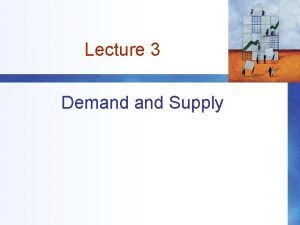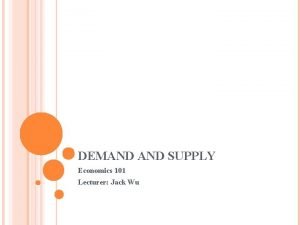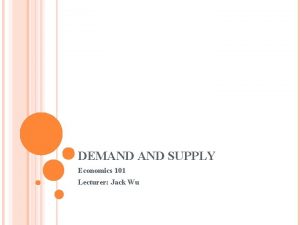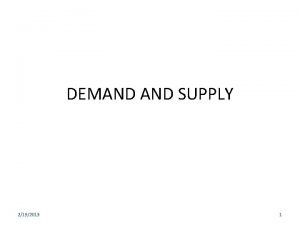Lecture 03 Demand Supply cont Lecturer Martin Paredes

































































- Slides: 65

Lecture # 03 Demand Supply (cont. ) Lecturer: Martin Paredes

Definition: The Market Supply function tells us how the quantity of a good supplied by the sum of all producers in the market depends on various factors Qs = f (p, po, w, …) 2

Definition: The Supply Curve plots the aggregate quantity of a good that will be offered for sale at different prices Qs = Q (p) 3

Example: Supply Curve for Wheat in Canada Price (dollars per bushel) Supply curve for wheat in Canada 0 0. 15 Quantity (billions of bushels per year) 4

Definition: The Law of Demand Curve states that the quantity of a good offered increases when the price of this good increases. ¡ Empirical regularity 5

l The supply curve shifts when factors other than own price change… If the change increases the willingness of producers to offer the good at the same price, the supply curve shifts right ¡ If the change decreases the willingness of producers to offer the good at the same price, the supply curve shifts left ¡ 6

l. A move along the supply curve for a good can only be triggered by a change in the price of that good. l A shift in the supply curve for a good can be triggered by a change in any other factor ¡A change that affects the producers’ willingness to offer the good. 7

Example: Canadian Wheat • QS = p +. 05 r • QS = quantity of wheat (billions of bushels) • p = price of wheat (dollars per bushel) • r = average rainfall in western Canada (inches) • • • Suppose price is $2 Quantity supplied no rainfall = $2 Quantity supplied with rainfall of 3” = $2. 15 • As rainfall increases, supply curve shifts right • (e. g. , r = 4 => Q = p + 0. 2) 8

Price ($) 0 Quantity, Billion bushels 9

Price ($) r=0 Supply with no rain 0 Quantity, Billion bushels 10

Price ($) r=0 r=3 Supply with no rain Supply with 3” rain 0. 15 Quantity, Billion bushels 11

Definition: A market equilibrium is a price such that, at this price, the quantities demanded and supplied are the same. l Demand supply curves intersect at equilibrium. 12

Example: Market for Cranberries • Suppose • QD = 500 – 4 P • QS = – 100 + 2 P • Where • P = price of cranberries (euros per barrel) • Q = demand or supply (in millions of barrels/year) 13

Example: Market for Cranberries • The equilibrium price is calculated by equating demand to supply: QD = Q S or 500 – 4 P = – 100 + 2 P • Solving for P: • To get equilibrium quantity, plug equilibrium price into either demand or supply • Into demand: Q* = 500 – 4(100) = 100 • Into supply: Q* = – 100 + 2(100) = 100 P* = 100 14

Example: The Market For Cranberries Price Market Supply: QS = -100 + 2 P 50 Quantity 15

Example: The Market For Cranberries Price 125 Market Supply: QS = -100 + 2 P 50 Market Demand: Qd = 50 – 4 P Quantity 16

Example: The Market For Cranberries Price 125 P*=100 Market Supply: QS = -100 + 2 P • 50 Market Demand: Qd = 50 – 4 P Q* = 100 Quantity 17

Definition: If at a given price, sellers cannot sell as much as they would like, there is excess supply. Definition: If at a given price, buyers cannot purchase as much as they would like, there is excess demand. 18

Example: Excess Supply in the Market For Cranberries Price 125 Market Supply 50 Market Demand Quantity 19

Example: Excess Supply in the Market For Cranberries Price 125 Market Supply 50 Market Demand Qd Q* QS Quantity 20

Example: Excess Supply in the Market For Cranberries Price 125 • Excess Supply • Market Supply 50 Market Demand Qd Q* QS Quantity 21

l If there is no excess supply or excess demand, there is no pressure for prices to change and we are in equilibrium. l When a change in an exogenous variable causes the demand curve or the supply curve to shift, the equilibrium shifts as well 22

Definition: The own price elasticity of demand is the percentage change in quantity demanded brought about by a one-percent change in the price of the good Q, P= ( % Q) = ( Q/Q) = ( % P) ( P/P) d. Q. P d. P Q 23

l Elasticity is not the slope l Slope is the ratio of absolute changes in quantity and price. (= d. Q/d. P). l Elasticity is the ratio of relative (or percentage) changes in quantity and price. 24

Q, P = 0 Perfectly inelastic demand l Quantity demanded is completely insensitive to changes in price 2. Q, P (-1, 0) Inelastic demand l Quantity demanded is relatively insensitive to changes in price 3. Q, P = -1 Unitary elastic demand l Percentage increase in quantity demanded equals percentage decrease in price 1. 25

4. Q, P (- , -1) Elastic demand l Quantity demanded is relatively sensitive to changes in price 5. Q, P = - Perfectly elastic demand l Any increase in price results in quantity demanded decreasing to zero l Any increase in price results in quantity demanded increasing to infinity. 26

Example: Linear Demand Curve • Suppose QD = a – b. P • a, b : positive constants • P: price • Notes: • -b is the slope • a/b is the choke price 27

Example: Linear Demand Curve • The elasticity is Q, P= d. Q. P = – b. P d. P Q Q • So for linear demand curves • Slope is constant. • Elasticity falls from 0 to - along the demand curve. • • E. g. , suppose Q = 400 – 10 P At P = 30, Q = 100, so Q, P= d. Q. P = – b. P = – 10. 30 = – 3 (elastic) d. P Q Q 100 28

Example: Elasticity with a Linear Demand Curve P 0 Q 29

Example: Elasticity with a Linear Demand Curve P a/b a/2 b 0 • a/2 a Q 30

Example: Elasticity with a Linear Demand Curve P a/b Q, P = - Elastic region a/2 b • Q, P = -1 Inelastic region Q, P = 0 0 a/2 a Q 31

Example: Constant Elasticity Demand Curve • Suppose QD = Apε • A: constant • P: price • ε : elasticity of demand • The elasticity is Q, P= d. Q. P = εApε-1. P = ε d. P Q Q • So for Constant Elasticity demand curves • Elasticity is constant. • Slope falls from 0 to - along the demand curve. 32

Example: A Constant Elasticity versus a Linear Demand Curve Price • P 0 Q Observed price and quantity Quantity 33

Example: A Constant Elasticity versus a Linear Demand Curve Price • P Observed price and quantity Linear demand curve 0 Q Quantity 34

Example: A Constant Elasticity versus a Linear Demand Curve Price • P Observed price and quantity Constant elasticity demand curve 0 Q Quantity 35

Example: A Constant Elasticity versus a Linear Demand Curve Price • P Observed price and quantity Constant elasticity demand curve Linear demand curve 0 Q Quantity 36

Example: A Constant Elasticity versus a Linear Demand Curve Price • 0 Quantity 37

l Factors that determine price elasticity of demand l Demand tends to be more price-elastic when there are good substitutes for the good l Demand tends to be more price-elastic when consumer expenditure in that good is large l Demand tends to be less price-elastic when consumers consider the good as a necessity. 38

Price Elasticity of Demand for Selected Grocery Products, Chicago, 1990 s 39

Source: Berry, Levinsohn and Pakes, "Automobile Price in Market Equilibrium, " Econometrica 63 (July 1995), 841 -890. Example: Price Elasticities of Demand for Automobile Makes, 1990. 40

l In general, for the elasticity of “Y” with respect to “X”: Y, X= ( % Y) = ( Y/Y) = ( % X) ( X/X) d. Y. X d. X Y 41

l Price elasticity of supply: measures curvature of supply curve ( % QS) = ( QS/QS) = d. QS. P ( % P) ( P/P) d. P QS 42

l Income elasticity of demand measures degree of shift of demand curve as income changes… ( % QD) = ( QD/QD) = d. QD. I ( % I) ( I/I) d. I QD 43

l Cross price elasticity of demand measures degree of shift of demand curve when the price of another good changes ( % QD) = ( QD/QD) = d. QD. P 0 ( % P 0) ( P 0/P 0) d. P 0 QD 44

Source: Berry, Levinsohn and Pakes, "Automobile Price in Market Equilibrium, " Econometrica 63 (July 1995), 841 -890. Example: The Cross-Price Elasticity of Demand for Cars 45

Source: Gasmi, Laffont and Vuong, "Econometric Analysis of Collusive Behavior in a Soft Drink Market, " Journal of Economics and Management Strategy 1 (Summer, 1992) 278 -311. Example: Elasticities of Demand for Coke and Pepsi 46

Use Own Price Elasticities and Equilibrium Price and Quantity 2. Use Information on Past Shifts of Demand Supply 1. 47

Choose a general shape for functions l Linear l Constant elasticity 2. Estimate parameters of demand supply using elasticity and equilibrium information l We need information on ε, P* and Q* 1. 48

Example: Linear Demand Curve • • Suppose demand is linear: QD = a – b. P Then, elasticity is Q, P = -b. P/Q • Suppose • Notice that, if = -b. P/Q b = - Q/P • • Then …and • Hence QD = 108. 5 – 55 P P = 0. 7 Q = 70 Q, P = -0. 55 b = -(-0. 55)(70)/(0. 7) = 55 a = QD + b. P = (70)+(55)(0. 7) = 108. 5 49

Example: Constant Elasticity Demand Curve • Suppose demand is: QD = APε • Suppose again • Notice that, if QD = APε A = QP-ε • Then • Hence QD = 57. 53 P-0. 55 P = 0. 7 Q = 70 Q, P = -0. 55 A = (70)(0. 7)0. 55 = 57. 53 50

Example: Broilers in the U. S. , 1990 Price • . 7 0 70 Observed price and quantity Quantity 51

Example: Broilers in the U. S. , 1990 Price • . 7 Observed price and quantity Linear demand curve 0 70 Quantity 52

Example: Broilers in the U. S. , 1990 Price • . 7 Observed price and quantity Constant elasticity demand curve 0 70 Quantity 53

Example: Broilers in the U. S. , 1990 Price • . 7 Observed price and quantity Constant elasticity demand curve Linear demand curve 0 70 Quantity 54

1. A shift in the supply curve reveals the slope of the demand curve 2. A shift in the demand curve reveals the slope of the supply curve. 55

Example: Shift in Supply Curve • • Old equilibrium point: New equilibrium point: • Both equilibrium points would lie on the same (linear) demand curve. • Therefore, if QD = a - b. P • • (P 1, Q 1) (P 2, Q 2) b = d. Q/dp = (Q 2 – Q 1)/(P 2 – P 1) a = Q 1 - b. P 1 56

Example: Identifying demand by a shift in supply Price Supply Market Demand 0 Quantity 57

Example: Identifying demand by a shift in supply Price New Supply Old Supply Market Demand 0 Quantity 58

Example: Identifying demand by a shift in supply Price New Supply Old Supply • P 2 P 1 • Market Demand 0 Q 2 Q 1 Quantity 59

This technique only works if the curve we want to estimate stays constant. Example: Shift in Supply Curve • We require that the demand curve does not shift 60

Price Supply Demand 0 Quantity 61

Price New Supply Old Demand New Demand 0 Quantity 62

Price New Supply • • P 2 P 1 Old Supply Old Demand New Demand 0 Q 2 = Q 1 Quantity 63

1. First example of a simple microeconomic model of supply and demand (two equations and an equilibrium condition) 2. Elasticity as a way of characterizing demand supply 3. Elasticity changes as market definition changes (commodity, geography, time) 64

4. Elasticity a very general concept 5. Back of the envelope calculations: ·Estimating demand supply from own price elasticity and equilibrium price and quantity ·Estimating demand supply from information on past shifts, assuming that only a single curve shifts at a time. 65
 Lecturer's name or lecturer name
Lecturer's name or lecturer name Cont or cont'd
Cont or cont'd Cont or cont'd
Cont or cont'd Module 5 supply and demand introduction and demand
Module 5 supply and demand introduction and demand Matching supply with demand
Matching supply with demand 01:640:244 lecture notes - lecture 15: plat, idah, farad
01:640:244 lecture notes - lecture 15: plat, idah, farad Jeannie watkins
Jeannie watkins Spe distinguished lecturer
Spe distinguished lecturer Good afternoon students
Good afternoon students Photography lecturer
Photography lecturer Lecturer in charge
Lecturer in charge Designation lecturer
Designation lecturer Designation of lecturer
Designation of lecturer Guest lecturer in geography
Guest lecturer in geography Lecturer name
Lecturer name Pearson lecturer resources
Pearson lecturer resources 140000/120
140000/120 Lector vs lecturer
Lector vs lecturer Lecturer in charge
Lecturer in charge Cfa lecturer handbook
Cfa lecturer handbook Lecturer asad ali
Lecturer asad ali Switch mode power supply lecture notes
Switch mode power supply lecture notes Inventory modeling
Inventory modeling Measures to correct excess and deficient demand
Measures to correct excess and deficient demand Individual demand vs market demand
Individual demand vs market demand What is dependent demand
What is dependent demand Kahulugan ng demand curve
Kahulugan ng demand curve Dependent demand inventory example
Dependent demand inventory example Methods of demand estimation
Methods of demand estimation Distinguish between individual demand and market demand
Distinguish between individual demand and market demand Dependent and independent demand in inventory management
Dependent and independent demand in inventory management Dilatação termica
Dilatação termica Columna de pared humeda
Columna de pared humeda Porque tu crees que el tiempo cura y las paredes tapan
Porque tu crees que el tiempo cura y las paredes tapan Celeste paredes
Celeste paredes Paredes compuestas
Paredes compuestas Musculos del abdomen
Musculos del abdomen Andres felipe paredes campos
Andres felipe paredes campos Pelvis falsa limites
Pelvis falsa limites Coxal
Coxal Dr nicolas paredes
Dr nicolas paredes No esquema
No esquema Florentino paredes
Florentino paredes Pielonefritis xantogranulomatosa
Pielonefritis xantogranulomatosa Sen(a+b)+sen(a-b)
Sen(a+b)+sen(a-b) Um aquario esferico de paredes finas
Um aquario esferico de paredes finas Unit 2 demand supply and consumer choice
Unit 2 demand supply and consumer choice 5 determinants of supply
5 determinants of supply Unit 2 demand supply and consumer choice
Unit 2 demand supply and consumer choice Money market equilibrium
Money market equilibrium Supply vs demand side economics
Supply vs demand side economics Combining supply and demand worksheet
Combining supply and demand worksheet Interaction of demand and supply
Interaction of demand and supply What is the relationship between supply and price
What is the relationship between supply and price Who are the suppliers of loanable funds
Who are the suppliers of loanable funds Loanable funds graph
Loanable funds graph Supply and demand economics project
Supply and demand economics project Chapter 6 section 2 supply and demand in everyday life
Chapter 6 section 2 supply and demand in everyday life Money supply and demand graph
Money supply and demand graph Supply demand rule
Supply demand rule Aggregate supply shifters
Aggregate supply shifters Long run aggregate supply curve
Long run aggregate supply curve Sras lras
Sras lras Aggregate demand supply graph
Aggregate demand supply graph Annual water supply and demand assessment
Annual water supply and demand assessment Aggregate demand and aggregate supply
Aggregate demand and aggregate supply

